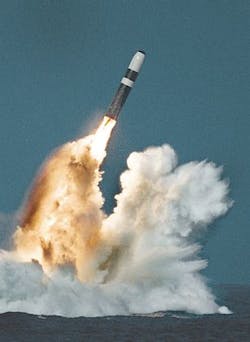Trident nuclear missile, C-5 cargo jet top DOD upgrade and technology-insertion plans for 2013
WASHINGTON, 20 Feb. 2012.Defense systems upgrades and technology-insertion programs, which are in place to keep today's military ships, ground, vehicles, aircraft, and other platforms in the field for as long as possible while improving system capability, represents a $14.44 billion market in the U.S. Department of Defense (DOD) 2013 budget request submitted to Congress last week.
Proposed spending of $14.44 billion for military systems upgrades in the 2013 DOD budget for procurement and research, development, test, and evaluation (RDT&E) is up slightly from current-year spending levels of $14.21 billion, but down from 2011 spending of $15.19 billion.
These numbers are derived from a line-by-line analysis of the 2013 DOD budget request for procurement and RDT&E, and do not reflect potential spending in the Pentagon's operations and maintenance or other budget requests, and do not reflect budget line items in which systems upgrades and military technology-insertion content is not apparent.
The 2013 DOD budget request proposes spending $13.12 billion for systems upgrade and technology-insertion procurement, and $1.33 billion for upgrades and technology-insertion RDT&E. The procurement request for 2013 is up slightly from current-year levels of $13.11 billion in 2012, and down from 2011 levels of $14.14 billion. The RDT&E request for 2013 is up slightly from current-year spending of $1.11 billion, and up also from 2011's level of $1.04 billion.
The largest technology upgrade program on the DOD's agenda for next year is a proposed $1.22 billion U.S. Navy initiative to upgrade the Trident II submarine-launched ballistic missile (SLBM). These sea-launched intercontinental nuclear missiles go to sea aboard the Navy's Ohio-class ballistic missile submarines, and are a central component of U.S. strategic nuclear deterrence.
The Navy operates 14 of these ballistic missile submarines, each of which can carry as many as 24 Trident II ballistic missiles. Although the Trident II is designed to carry as many as 12 independently targeted warheads, current treaties reduce this number to four or five. The Charles Stark Draper Laboratory Inc. in Cambridge, Mass., is in charge of upgrading the Trident II's guidance system, and has been working on this project since 2005.
Another billion-dollar upgrade program on tap for next year is the U.s. Air Force's initiative to upgrade the Lockheed Martin C-5 Galaxy giant cargo jet to the C-5M Super Galaxy version, which involves new engines and modernized avionics to extend the cargo jet's service life beyond 2040. For 2013 the Air Force is requesting $1.01 billion for C-5M modifications.
The Super Galaxy program also involves the C-5 Avionics Modernization Program (AMP) to upgrade the aircraft's avionics to Global Air Traffic Management compliance, improving communications, installing new flat-panel displays, improving navigation and safety equipment, and installing a new autopilot system. The first flight of an AMP-upgraded C-5 was in 2002.
U.S. Army officials also have big system upgrade and technology-insertion plans for next year, with a $927.4 million proposal to modify the Mine-Resistant Ambush-Protected (MRAP) armored combat vehicle, which is designed to withstand blasts from roadside bombs and carry a wide variety of combat-support and surveillance and reconnaissance missions.
The U.S. Navy has two big-ticket system upgrade and technology-insertion programs planned for 2013 -- an $807.5 million initiative to up grade the UH-1Y and AH-1Z utility and attack helicopters operated by the U.S. Marine Corps. The Navy also has a $688.5 million project to upgrade the F/A-18 Hornet series of carrier-based jet fighters and fighter-bombers.
The Navy also has a $452.4 million program planned for 2013 to upgrade versions of the Arleigh Burke-class guided missile destroyer, while the Air Force is planning a $283.9 million project to upgrade the F-22A Raptor air-superiority jet fighter.
Among the largest systems upgrade and technology-insertion research and development programs set for next year is an overall $280.25 million Army plan for aircraft modifications and product improvements; a $188 million Air Force to improve aircraft engine components; a $180.6 million Army plan for the High Performance Computing Modernization Program; and the $140.1 million Air Force F-22 Modernization Increment 3.2B program.
